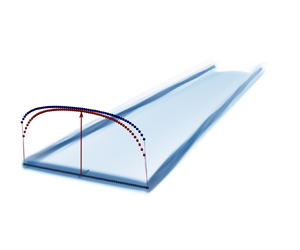No CrossRef data available.
Published online by Cambridge University Press: 29 July 2024

The actuator line method (ALM) is a commonly used technique to simulate slender lifting and dragging bodies such as wings or blades. However, the accuracy of the method is significantly reduced near the tip. To quantify the loss of accuracy, translating wings with various aspect and taper ratios are simulated using several methods: wall-resolved Reynolds-averaged Navier–Stokes (RANS) simulations, an advanced ALM with two-dimensional (2-D) mollification of the force, a lifting line method, a mollified lifting line method and a vortex lattice method. Significant differences in the lift and drag distributions are found on the part of the wing where the distance to the tip is smaller than approximately 3 chords and are identified to arise from both the forces mollification and the uneven induced velocity along the chord. Correction functions acting on the lift coefficient and effective angle of attack near the wing tip are then derived for rectangular wings of various aspect ratios. They are then also applied to wings of various taper ratios using the ‘effective dimensionless distance to the tip’ as the main parameter. The application of the correction not only leads to a much improved lift distribution, but also to a more consistent drag distribution. The correction functions are also obtained for various mollification sizes, as well as for ALM with three-dimensional (3-D) mollification. These changes mostly impact the correction for the effective angle of attack. Finally, the correction is applied to simulations of the NREL Phase VI wind turbine, leading to an enhanced agreement with the experimental data.